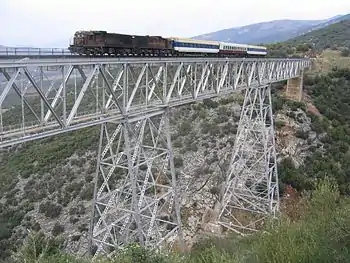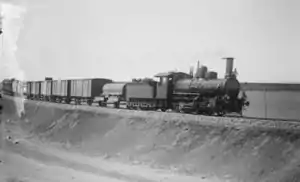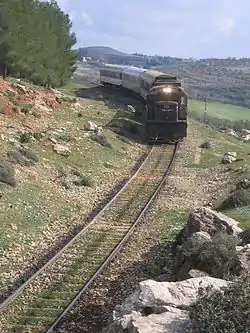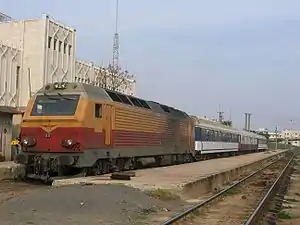Syrian Railways
General Establishment of Syrian Railways[1] (Arabic: المؤسسة العامة للخطوط الحديدية,[2] French: Chemins de fer syriens, CFS) is the national railway operator for the state of Syria, subordinate to the Ministry of Transportation.[3] It was established in 1956 and is headquartered in Aleppo.[4][5] Syria's rail infrastructure has been severely compromised as a result of the ongoing civil conflict in the country.




 Modern CFS passenger train, hauled by General Electric Class U17C, north of Aleppo on the former Baghdad Railway | |
| Overview | |
|---|---|
| Headquarters | Aleppo |
| Locale | Syria |
| Dates of operation | 1956–present |
| Predecessor | Damas, Hamah et Prolongements Hejaz railway |
| Technical | |
| Track gauge | 1,435 mm (4 ft 8 1⁄2 in) standard gauge |
| Length | 2,423 km |
| Other | |
| Website | https://www.cfssyria.sy |


History
The first railway in Syria opened when the country was part of the Ottoman Empire, with the 1,050 mm (3 ft 5 11⁄32 in) gauge line from Damascus to the port city of Beirut in present-day Lebanon opened in 1895. The famous Hejaz railway opened in 1908 between Damascus and Medina in present-day Saudi Arabia also used 1,050 mm (3 ft 5 11⁄32 in) gauge. Railways after this point were built to 1,435 mm (4 ft 8 1⁄2 in) standard gauge, including the Baghdad Railway.[6] The French wanted an extension of the standard gauge railway to connect with the Palestine Railways and so agreed the building of a branch line to Tripoli, Lebanon, operated by Société Ottomane du Chemin de fer Damas-Hama et prolongements, also known as DHP.[7]
The Baghdad Railway had progressed as far as Aleppo by 1912, with the branch to Tripoli complete, by the start of World War I; and onwards to Nusaybin by October 1918. The Turks, who sided with Germany and the Central Powers, decided to recover the infrastructure south of Aleppo to the Lebanon in 1917. The Baghdad Railway created opportunity and problems for both sides, being unfinished but running just south of the then defined Syrian/Turkish border.[7] Post war, the border was redrawn, and the railway was now north of the border. DHP reinstated the Tripoli line by 1921. From 1922 the Baghdad Railway was worked in succession by two French companies, who were liquidated in 1933 when the border was again redrawn, placing the Baghdad Railway section again in Syrian control. Lignes Syriennes de Baghdad (LSB) took over operations, a subsidiary of DHP.[7]
The next big developments in Syrian railways were due to the political manoeuvering leading up to and during World War II. As Turkey had sided with Germany in World War One, the Allies were concerned with poor transport in the area, and their ability to bring force on the Turks. Having built railways extensions in both the Eastern and Western deserts of Egypt, they initially operated services via the Hejaz Railway, but were frustrated by the need to transload goods due to the gauge break. They surveyed a route from Haifa to Rayak in 1941, but decided there were too many construction difficulties. The standard gauge line from Beirut to Haifa was eventually built by Commonwealth military engineers from South Africa and Oceania during WWII, in part supplied by a 1,050 mm (3 ft 5 11⁄32 in) gauge railway to access materials.[7] Ultimately, Turkey remained neutral and refused the Allies access to their jointly controlled sections of the Baghdad Railway, although by then the Allies had driven the Palestine Railway through to Al Akkari, Homs, Hama and onward to connect with the Baghdad Railway at Aleppo.[7]
Locomotives servicing the Allied war effort included the British R.A. Riddles designed WD Austerity 2-10-0, four of which post war went into Syrian service, designed CFS Class 150.6.[8][9]
In 1956, all railways in Syria were nationalised, and reorganised as CFS (Chemins de Fer Syriens) from 1 January 1965. Expanded with monetary and industrial assistance from the USSR, the agreement covered the joint industrial development of the country. Covering the development of the ports of Tartus and Latakia, they were initially connected by rail to Al Akkari and Aleppo in 1968 and 1975 respectively. An irrigation project on the Euphrates, resulting in the construction of the Tabqa Dam, drove the connection of Aleppo to Al-Thawrah (1968), Raqqa (1972) Deir ez Zor (1973), reaching the old Baghdad Railway at Al Qamishli in 1976.[7]
Tramway
| Location | Traction Type |
Date (From) | Date (To) | Notes |
|---|---|---|---|---|
| Halab حلب /Aleppo | Electric | 1929 | 1967 | . |
| Dimashq دمشق /Damascus | Electric | 7 Feb 1907 | 1967 | . |
Current system
Network
| Chemins de Fer Syriens | |||||||||||||||||||||||||||||||||||||||||||||||||||||||||||||||||||||||||||||||||||||||||||||||||||||||||||||||||||||||||||||||||||||||||||||||||||||||||||||||||||||||||||||||||||||||||||||||||||||||||||||||||||||||||||||||||||||||||||||||||||||||||||||||||||||||||||||||||||||||||||||||||||||||||||||||||||||||||||||||||||||||||||||||||||||||||||||||||||||||||||||||||||||||||||||||||||||||||||||||||||||||||||||||||||||||||||||||||||||||||||||||||||||||||||||||||||||
|---|---|---|---|---|---|---|---|---|---|---|---|---|---|---|---|---|---|---|---|---|---|---|---|---|---|---|---|---|---|---|---|---|---|---|---|---|---|---|---|---|---|---|---|---|---|---|---|---|---|---|---|---|---|---|---|---|---|---|---|---|---|---|---|---|---|---|---|---|---|---|---|---|---|---|---|---|---|---|---|---|---|---|---|---|---|---|---|---|---|---|---|---|---|---|---|---|---|---|---|---|---|---|---|---|---|---|---|---|---|---|---|---|---|---|---|---|---|---|---|---|---|---|---|---|---|---|---|---|---|---|---|---|---|---|---|---|---|---|---|---|---|---|---|---|---|---|---|---|---|---|---|---|---|---|---|---|---|---|---|---|---|---|---|---|---|---|---|---|---|---|---|---|---|---|---|---|---|---|---|---|---|---|---|---|---|---|---|---|---|---|---|---|---|---|---|---|---|---|---|---|---|---|---|---|---|---|---|---|---|---|---|---|---|---|---|---|---|---|---|---|---|---|---|---|---|---|---|---|---|---|---|---|---|---|---|---|---|---|---|---|---|---|---|---|---|---|---|---|---|---|---|---|---|---|---|---|---|---|---|---|---|---|---|---|---|---|---|---|---|---|---|---|---|---|---|---|---|---|---|---|---|---|---|---|---|---|---|---|---|---|---|---|---|---|---|---|---|---|---|---|---|---|---|---|---|---|---|---|---|---|---|---|---|---|---|---|---|---|---|---|---|---|---|---|---|---|---|---|---|---|---|---|---|---|---|---|---|---|---|---|---|---|---|---|---|---|---|---|---|---|---|---|---|---|---|---|---|---|---|---|---|---|---|---|---|---|---|---|---|---|---|---|---|---|---|---|---|---|---|---|---|---|---|---|---|---|---|---|---|---|---|---|---|---|---|---|---|---|---|---|---|---|---|---|---|---|---|---|---|---|---|---|---|---|---|---|---|---|---|---|---|---|---|---|---|---|---|---|---|---|---|---|---|---|---|---|---|---|---|---|---|---|---|---|---|---|---|---|---|---|---|---|---|---|---|---|---|---|---|---|---|---|---|---|---|---|---|---|---|
| |||||||||||||||||||||||||||||||||||||||||||||||||||||||||||||||||||||||||||||||||||||||||||||||||||||||||||||||||||||||||||||||||||||||||||||||||||||||||||||||||||||||||||||||||||||||||||||||||||||||||||||||||||||||||||||||||||||||||||||||||||||||||||||||||||||||||||||||||||||||||||||||||||||||||||||||||||||||||||||||||||||||||||||||||||||||||||||||||||||||||||||||||||||||||||||||||||||||||||||||||||||||||||||||||||||||||||||||||||||||||||||||||||||||||||||||||||||
Today, all 1,435 mm (4 ft 8 1⁄2 in) network and trains are operated by CFS. Using all diesel-electric powered traction, the main routes prior to the Syrian Civil War were:[4][12]
- Damascus - Homs - Hamah - Aleppo - Maydan Ikbis (- Ankara TCDD)
- Aleppo - Latakia - Tartus - Al Akkari - Homs
- Homs - Palmyra: freight only, opened for phosphates traffic, destined for the port of Tartus, in 1980
- Line runs from the oilfields of Al Qamishli in the north to the port of Latakia (750 km)
- Al Akkari (- Tripoli CEL, out of use)
- Aleppo - Deir ez-Zor - Al-Qamishli (- Nusaybin TCDD)
- Extension from Homs southwards to Damascus (194 km) was opened in 1983
- 80 km (50 mi) Tartus-Latakia line in 1992
- Al Qamishli - Al-Yaarubiyah (- IRR Iraq, out of use)
- Damascus - Sheikh Miskin - Dera'a: under construction, to replace a section of Hejaz railway
- Sheikh Miskin - Suwayda (under construction)
- Palmyra - Deir ez-Zor - Abu Kemal (- IRR Iraq) (planned)
Pre-war proposals
Prior to the civil war there was a proposal for a connection with Iraq between Dayr az Zawr and Al Qa’im.[13] However, all international routes operated by Syrian Railways were suspended due to the outbreak of the Syrian Civil War.
Trackage
These were the figures prior to the ongoing Syrian conflict:
- total: 2,750 km (1,710 mi)
- standard gauge: 2,423 km (1,506 mi) 1,435 mm (4 ft 8 1⁄2 in) gauge
- narrow gauge: 327 km (203 mi) 1,050 mm (3 ft 5 11⁄32 in) gauge (2000) Chemin de Fer de Hedjaz Syrie
Operations

The network is designed wholly around diesel-electric traction. For operational purposes CFS is divided into three regions: Central, Eastern and Northern. At the end of 2004 CFS employed around 12,400 staff.
The system has a low level capacity, with top speed usually limited. A 30 km (19 mi) section of the Damascus - Aleppo line was designed for speeds reaching 120 km/h (75 mph), but most of the track has a limit of 110 km/h (68 mph). Most tracks of the CFS are limited to 80 km/h (50 mph). Operational train speed is also limited by a lack of interlocked signalling, with most of the system operating by informal signalling. The Damascus al-Hijaz railway station, which lies in the city centre, is no longer operational, and the railway connections with other cities depart from the suburban station of Kadam.
The result is that most passenger traffic has moved to air-conditioned coaches, and freight traffic dominates the operational trackage. The 2005 introduction of South Korean-built DMUs, where drivers were trained using a simulator,[14] on the Damascus - Aleppo route, and the high traffic Aleppo - Latakia route where intermediate stations are bypassed, resulted in higher usage and occupancy levels.
The only remaining section of narrow gauge line, running from a point on the outskirts of Damascus into Jordan, is operated by Jordan Hejaz Railways.
International connections
The only international connection was with Turkey, but that link was halted due to the Syrian Civil War.[15] The link with Iraq, severed in the war of 2003, was restored for a time but closed again; there was a plan to reopen it in June 2009.[16] In 2008 it was proposed to open a joint rolling stock factory with Turkish State Railways at Aleppo.
From London / Paris to Aleppo / Damascus by train
The international connection of the Syrian railways with Turkey allows passengers to travel from London or Paris to any city in Syria by train:
Step 1: Travel to Istanbul
First, you need to reach Istanbul from London, Paris or other European cities.
Step 2: Istanbul to Syria
Once in Istanbul, it's easy to travel overland to Aleppo & Damascus in Syria, taking a daily air-conditioned sleeper train leaving Istanbul late at night. This is a relaxing journey in the comfort and privacy of a modern air-conditioned sleeping-car travelling through great scenery in southern Turkey on the way to Syria.[17]
Background on trains from Istanbul to Syria: A brief history of the Taurus Express:
Agatha Christie wrote the first part of her novel Murder on the Orient Express during her stay in room 203 in Baron Hotel in Aleppo.[18] The novel doesn't start in Istanbul, or on the Orient Express. It opens on the platform at Aleppo, next to the two blue-and-gold Wagons-Lits sleeping cars of the Taurus Express bound for Istanbul. The Taurus Express was inaugurated in February 1930 by the Compagnie Internationale des Wagons-Lits, the same company that operated the Orient Express and Simplon Orient Express, as a means of extending their services beyond Istanbul to the East. It ran several times a week from Istanbul Haydarpaşa station to Aleppo and Baghdad, with a weekly through sleeper to Tripoli in Lebanon. After the second world war, the Wagons-Lits company gradually withdrew and operation of the Taurus Express was taken over by the Turkish, Syrian and Iraqi state railways. Up until the late 1980s, a twice-weekly Istanbul-Baghdad service was maintained, with weekly through seating cars from Istanbul to Aleppo. For political reasons, the through service to Baghdad was suspended and the main train curtailed at Gaziantep, but the weekly through seat cars Istanbul-Aleppo were maintained. In 2001, the Aleppo portion of the Toros Express was speeded-up and given a proper Syrian sleeping-car instead of the two very basic Turkish seat cars. You could once again travel in the security and comfort of a proper sleeper from Istanbul to Syria, and it was a great way to go.[17]
Motive power
The motive power in 2007 was noted as:[19]
| Class | Image | Axle Formula | Number | Year in Service | Power [kW] |
Max.Speed [km/h] | Traction Type* | Notes |
|---|---|---|---|---|---|---|---|---|
| unknown |  |
Steam locomotive in Bosra | ||||||
| LDE-650 | Bo-Bo | 9 | 1968 | 478 | DE | Shunting locomotives built in France | ||
| LDE-1200 | Co-Co | 11 | 1973 | 883 | 100 | DE | TEM2 Shunting locomotives built in Russia, 346 kN tractive effort | |
| LDE-1500 | Co-Co | 25 | 1982 | 1102 | DE | Czechoslovakia, similar to CD(CZ) ČSD Class T 669.0 | ||
| LDE-1800 |  |
Co-Co | 26 | 1976 | 1323 | DE | American built General Electric U17C export model. 30 originally built in 2 batches | |
| LDE-2800 |  |
Co-Co | 77 | 1982 | 2058 | 100 | DE | Russian TE114, 110 originally built. Partly modernised by General Electric in 2000 by fitting 12cyclinder GE FDL of 3000 hp[20] |
| LDE-3200 |  |
Co-Co | 30 | 1999 | 2400 | 120 | DE | Alstom DE32CAC diesel locomotives, engines by Ruston 3,200 hp (2,400 kW).[21][22] |
| DMU-5 |  |
10 | 2006 | 1680 | 120/160 | DH | Multiple unit from Hyundai Rotem, Korea for Aleppo-Damascus/Latakia long-distance services. 222 second class, 61 first class | |
| * DH = Diesel-hydraulic, DE = Diesel-electric | ||||||||
Passenger vehicles
The railway possessed:[19]
- Passenger carriages: almost all OSShD-Y obtained mainly from the former Deutsche Reichsbahn of German Democratic Republic, the newest of which were obtained from Căile Ferate Române of Romania and Polish State Railways. The stock of 483 carriages includes: 19 restaurant, 45 sleepers and 33 baggage vans. In 2001, Iranian company Wagon Pars refurbished some stock which is still in use, while the remaining unused stock lie rotting in sidings.
| Class | Image | Number | Year in Service | Notes |
|---|---|---|---|---|
| Type Y[23] |  |
358 | 1982-'83 | Original built for Damascus - Homs-line by VEB Bautzen. Delivered in orange-cream Städteexpress-livery |
Freight wagons

- Goods wagons: freight trains are organised into block workings, covering shipments of: oil, natural gas, phosphates, grain, cement, containers, construction materials and other transports. Most of 4319 vehicles were built between 1960–1975, with the most modern stock the grain wagons imported from Iran in the early 1990s. Approximate figures for stock:
- 1294 Heavy Flat wagons
- 846 Open wagons
- 818 Oil tankers
- 762 Covered wagons
- 597 Grain wagons
- 323 Phosphate wagons
- 178 Sliding wall wagons
- 146 Self unloading wagons
- 53 Flat wagons
- 50 Natural gas tankers
- 45 Cement wagons
- 20 Water tankers
- 19 Tippers
Retired
| Class | Image | Axle Formula | Number | Year in Service | Power [kW] |
Max.Speed [km/h] | Notes |
|---|---|---|---|---|---|---|---|
| De Dion Bouton | railcar | 1930 | Built for Hejaz Railway | ||||
| Ganz/MAVAG R12 | railcar | ||||||
| SGP AB49000[24][25] | B'B' Railcar | 7 | 1966 | 470 | 100 | Length: 26 meters. 20 seats 1st class; 58 seats 2nd class. |
References
- "الرئيسية." (Home page) Syrian Railways. 26 October 2007. Retrieved on 22 October 2013.
- "اتصـال." Syrian Railways. 16 June 2006. Retrieved on 22 October 2013.
- "Hme page." Syrian Railways. 21 May 2006. Retrieved on 22 October 2013.
- "Chemins de fer Syriens". Ferenc Valoczy. Retrieved 2009-05-03.
- "Contact us." Syrian Railways. 17 June 2006. Retrieved on 22 October 2013. "Syrian Arab Republic Ministry of Transportation Syrian Railways Syria - Aleppo"
- http://www.sinfin.net/railways/world/syria.html
- Hugh Hughes. "Middle East Railways". almashriq.hiof.no. Retrieved 2009-05-05.
- Rowledge, J.W.P. (1987). Austerity 2-8-0s & 2-10-0s. London: Ian Allan.
- "CFS Motive Power". Retrieved 2009-05-04.
- List of town tramway systems in Asia#Syria
- Note: the old Baghdad Railway from Al-Rai to Nusaybin forms the border line between Syria and Turkey, with stations accessible from Syria.
- "Chemins de fer Syriens". Jaynes. Archived from the original on 2013-01-27. Retrieved 2009-05-03.
- http://www.railwaysafrica.com/blog/2014/03/25/syrian-national-railway-plans/#sthash.ssE4XqfM.dpuf
- "Syrian train simulator". YouTube. April 15, 2008. Retrieved May 7, 2009.
- Inc., Tom Brosnahan, Travel Info Exchange. "Trains Turkey <—> Syria". www.turkeytravelplanner.com. Retrieved 2017-01-29.
- "June launch scheduled for Iraq-Syria railway". arabiansupplychain.com. April 29, 2009. Archived from the original on June 28, 2009. Retrieved May 3, 2009.
- https://www.seat61.com/Syria.htm#London%20to%20Aleppo
- Times, Alan Cowell, Special To The New York (1990-02-24). "Aleppo Journal; A Small Hotel, Its Memories Fading". The New York Times. ISSN 0362-4331. Retrieved 2017-05-20.
- "CFS". railfaneurope.net. 2007-06-25. Retrieved 2007-05-03.
- "GE Locomotives in Asia & Middle East". locopage.net. Retrieved 2009-05-04.
- "PRIMA DE 32 C AC diesel locomotives, Syria". www.transport.alstom.com. Alstom. Archived from the original on 17 October 2005.
- Railfaneurope.net : Syrian diesels
- HaRakevet: Rothschild PhD, Rabbi Walter (December 2004), Modelling notes - Syrian coaches. Series 17:4 issue 67
- Flickr.com
- Source
.jpg.webp)